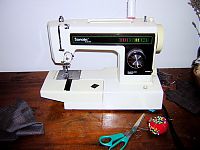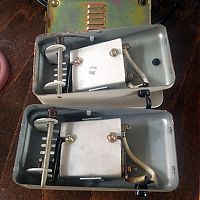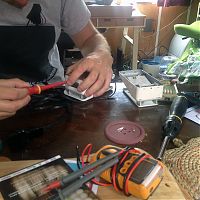The Sonata is Saved
My main sewing machine is a Joann Sonata, metal-body sewing machine, produced in 1984 and running on a voltage converter since my mom brought it over in her suitcase 12 years ago. It was a gift from my sister-in-law, having been in her family for the past 30 years, and it has been sewing like a dream through pretty much everything you’ve seen on this site since I started writing it in 2005.

The Sonata in 2006(?), pre-boatlife
In all that time, I’ve never taken it to be serviced, and – I’ll admit – I’m not the most regular oil-er, either. But everything was fine until a few months ago, when the foot pedal started to feel decidedly jerky. I’d have to press down quite far before the machine would respond, and then it’d be off at positively industrial speed.
This I could live with.
But then it started to continue sewing even after I’d left my foot off the pedal, sewing off happily into the beyond at lightspeed, leaving me to scream and kill the power switch. Obviously this could not really continue, so I begrudgingly rang up the Maury sewing machine repair shop I’d used a few years ago when my overlocker looper got bent out of shape. The shop isn’t that far away, but since the machine is heavy, I’d been dreading taking it up there, as I’d need James to drive me out on a Saturday.
I’m going to reiterate again that my machine is some random-ass brand no-one’s ever heard of, running on a foreign voltage. But he listened to the issue, and without even needing to open up the case to look at it, told me several ways he could fix it (he’d usually just graft on a new pedal, but with mine being 110v that’d be a long eBay wait). Plus I wanted a few other tweaks and a good oiling, and he said he’d give me a ring when he knew more. I should digress at this point to say that I also brought my overlocker along because I’d bought a replacement upper blade but didn’t have the special Bernina wrench required to take the &%^#% old one off. He swapped it over as I stood there (no charge!), then as we were leaving, ran out into the rain to tell me exactly which wrench to buy if I’d like to change it myself in future. What a dude!


